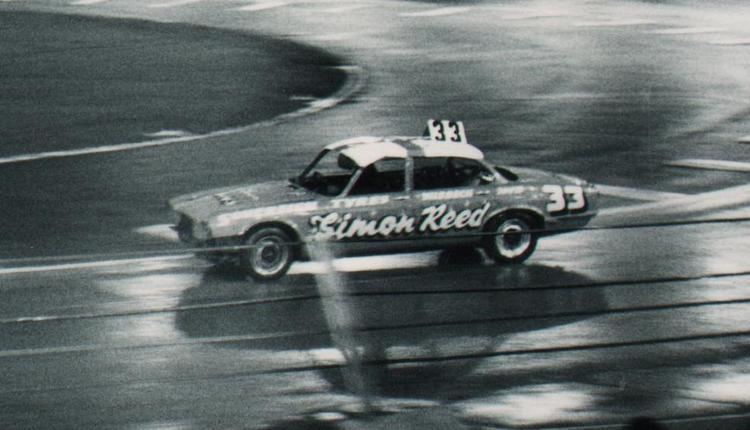 | ||
Banger racing is a tarmac or dirt track racing type of motorsport event popularised in Europe and especially United Kingdom, Ireland, Belgium and the Netherlands in which drivers of old vehicles race against one another on a race track. The race is won by the first car to the chequered flag after a set number of laps. The race tracks are usually oval, around 440 yards (400 metres) but on occasion are constructed in a figure eight design.
Contents
Vehicles and races
Banger racing vehicles are normally scrap cars, but they can be constructed from almost any powered wheeled vehicle with bizarre versions of the sport using cars towing caravans as special events at some tracks. There are different events for different vehicle types, often with prizes for the best presented and rarest vehicles.
Early days
Banger racing is said to have started in the early 1960s after it was observed by a race promoter that crashes were among the most popular features of a race meeting. Drivers began turning out vehicles with very basic preparation - cars would have the windows removed but often whole interiors would be left inside. Safety regulations began to improve in the 1980s with bangers being prepared with compulsory 'H frame' roll cages, driver's door plates, and fuel tanks moved inside the car. From these humble beginnings, the sport has become the premier formula in short oval racing in the UK and Ireland, regularly drawing the largest numbers of both competitors and spectators. Around 1990, promoters began hosting 'open' meetings with significant prize funds; the first of these being held at Ringwood Raceway's 'British Open' and The Arena Essex 'Firecracker 500'. The Unlimited Banger World Final was held at Wimbledon Stadium, London from 1974 until 2007. From 2008 it was relocated to Ipswich. The peak number of cars to compete in one season was around 13,000 in 2003, of which around 9,500 were 'fresh' (not previously raced). The 'Icebreaker' meeting, held at Swaffham Raceway on February 8, 1998 is widely regarded as the 'best ever' event, drawing 209 competitors in a day of heavy action. The annual "Heavy Metal Classic" event in January of each year at Standlake Arena, has on several occasions attracted the highest number of competitors. In 2009, the Heavy Metal Classic meeting attracted a total of 253 cars booked in to race.
Racing
A Banger race is distinct from a demolition derby as the objective of the latter is not to turn laps, but to smash, destroy and ultimately immobilise the opposition, until only one vehicle is left. On many occasions, though, the last event of the day at a banger racing event may be a demolition derby and, the cars are already well used before being partially or fully destroyed.
Despite the racing element of the sport, drivers are often split into two categories: those who are 'rodders' (derived from the hot rod formulas) who aim to win races, and those who are 'wreckers' and compete with the intention of damaging other cars. Wreckers are often more popular with the crowd, although drivers who win races and qualify for the world final are also respected. Along with trophies for race wins, there are often trophies presented for 'best wrecker' and 'best entertainer' along with 'demolition derby winner' in order to attract drivers of both persuasions. Another trophy often given is a 'best car' award which is usually either given to the best presented vehicle or the rarest car; with the latter being the subject of much controversy with classic car enthusiasts.
Sometimes with over forty cars starting a race, the cars are gridded across the track in a rolling start for the race, which usually has a finite number of laps (twelve, fifteen or twenty).
In a banger race, yellow flags are used during the race to warn drivers that caution is required. Cars which stall or are stopped by opposing drivers are usually left on the course while the race continues. In recent times, drivers have been encouraged to remain inside a disabled car while the race continues, as this is adjudged to be the safest option. If it is deemed necessary to move them or if a driver is in particular danger (including fire), a red flag may be used to stop the race. Races are then usually restarted when the situation has been cleared.
Other dimensions
There are further dimensions to this sport apart from the actual racing - one is the quest for interesting vehicles to wreck and race, often dividing opinions between banger drivers and classic car enthusiasts. In addition to this, there is a recent trend for semi-professional car preparation both in terms of performance and appearance. These developments have moved the sport away from the "scrap-car", cheap motorsport area and provide higher profile entertainment. At 'major' or 'title' events, the cars are meticulously prepared to high standards. In recent years, top drivers have invested significantly in race-tuned engines, 'sticky' tyres and even suspension set-ups.
Critics
Some vehicle enthusiasts object to banger racing on the grounds that it is responsible for the destruction of countless classic cars and the reason why many models, such as the Austin Westminster have become a very rare sight on the road. This argument is often rejected by the banger community, who maintain that a large percentage of vehicles raced are beyond restoration.
